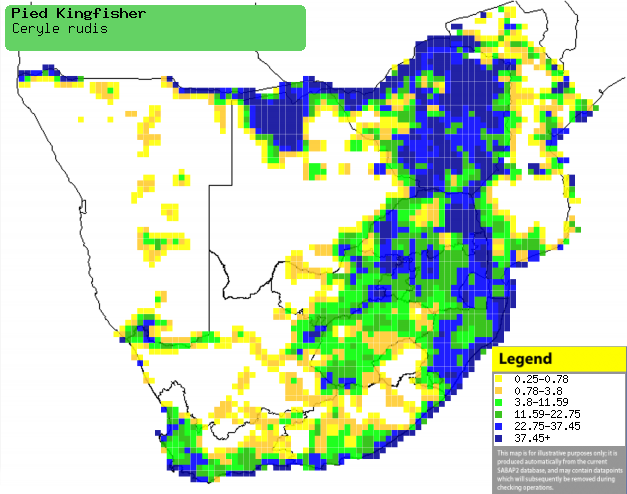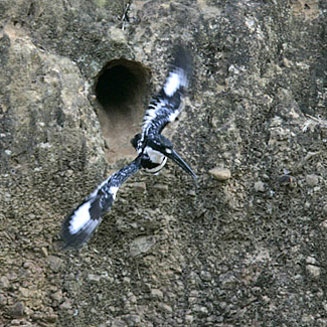|
Ceryle rudis (Pied kingfisher)
Bontvisvanger [Afrikaans]; Isaxwila (generic term for
kingfisher) [Xhosa]; iHlabahlabane, isiQuba, isiXula [Zulu]; Muningi (generic
term for kingfisher) [Kwangali]; Seinoli (generic term for kingfisher) [South
Sotho]; Chinyurirahove [Shona]; Lonombe [Swazi]; Tshololwana (generic term for
kingfisher) [Tsonga]; Mmatlhapi, SeinŰdi (generic terms for kingfisher)
[Tswana]; Bonte ijsvogel [Dutch]; Martin-pÍcheur pie [French]; Graufischer
[German]; Pica-peixe-malhado [Portuguese]
Life
> Eukaryotes >
Opisthokonta
> Metazoa (animals) >
Bilateria >
Deuterostomia > Chordata >
Craniata > Vertebrata (vertebrates) > Gnathostomata (jawed
vertebrates) > Teleostomi (teleost fish) > Osteichthyes (bony fish) > Class:
Sarcopterygii (lobe-finned
fish) > Stegocephalia (terrestrial
vertebrates) > Tetrapoda
(four-legged vertebrates) > Reptiliomorpha > Amniota >
Reptilia (reptiles) >
Romeriida > Diapsida > Archosauromorpha > Archosauria >
Dinosauria
(dinosaurs) > Saurischia > Theropoda (bipedal predatory dinosaurs) >
Coelurosauria > Maniraptora > Aves (birds) > Order: Coraciiformes
> Family: Cerylidae
The Pied kingfisher is one of the most common kingfishers
in the world, being found in many areas of Africa and Eurasia, living in a wide
range of aquatic habitats. It feeds mainly on fish, spotting prey by either
sitting on perches or hovering, which it does more than any other kingfisher. It
is a cooperative breeder, meaning that the breeding pair are assisted by
helpers, who can either be offspring, or unrelated birds, who's breeding
attempts failed. The chicks stay in the nest for 24-29 days, after which they
are still dependent on their parents for 1-2 months.
Distribution and habitat
One of the most common kingfishers
in the world, occurring in the middle east, southern Asia to China, Egypt and
Africa south of the Sahel. In southern Africa, it is common in many
areas, including South Africa, northern Botswana and Zimbabwe. It can live at
any water body, as long as there are small fish, such as streams, rivers, lakes,
temporary pans, estuaries, temporarily flooded areas and rocky coasts.
|
 |
|
Distribution of Pied kingfisher in southern
Africa, based on statistical smoothing of the records from first SA Bird
Atlas Project (©
Animal Demography unit, University of
Cape Town; smoothing by Birgit Erni and Francesca Little). Colours range
from dark blue (most common) through to yellow (least common).
See here for the latest distribution
from the SABAP2. |
Predators
It has been recorded as prey of the following
animals:
Food
Feeds mainly on fish, supplemented with invertebrates. It often uses
the hovering
technique for catching fish, searching for prey from a high vantage point in the
air, then
diving straight down into the water to grab the prey item. It immediately flies back to its perch, where it beats the prey to death then
swallows it
(see fig. 4 above). The following prey items have been recorded in its diet:
- Fish
- Pseudocrenilabrus philander (Southern mouthbrooder)
- alastine characins (of the Characidae family)
- Barbus (barbs)
- Barbus paludinosus (Straightfin
barb)
- Oreochromis mossambicus (Mozambique tilapia)
- Gilchristella aestuaria (Estuarine roundherring)
- Invertebrates
Breeding
- Monogamous cooperative breeder, which means that
the breeding pair are assisted by other birds. Primary
helpers are usually one year old offspring of the breeding pair, and help with incubation, the
caring of the chicks and the defending of their territory.
Secondary helpers usually appear after the chicks have hatched and are
initially rejected by the breeding pair, playing a lesser role than the
primary helpers. Secondary helpers are unmated adults, due to failed breeding
attempts. They are also have reduced testosterone levels and small testes,
rendering them incapable of mating again.
- The nesting site is excavated into a vertical sandbank by both sexes,
and consists of a 0.8-1.2m long tunnel, leading to a 20-30cm wide chamber.
It digs by stabbing with its open bill, interspersed with kicking out sand
with its feet.
 |
|
|
Pied kingfisher flying into its burrow, Modimolle,
South Africa. [photo
Warwick Tarboton ©] |
|
- Egg-laying season is from July-April in Zimbabwe, April-June and
September-October in Botswana and from August-November in South Africa.
- It lays 1-7, usually 4-6 eggs, which are incubated mainly by the female
for about 18 days.
- The chicks stay in the nest for 24-29 days, after which they learn to
hunt. At 38-43 days old, they can dive and eat for themselves, but they only
become fully independent 1-2 months after fledging.
Threats
Not threatened, in fact is one of three most common
kingfishers in the world. In southern Africa, it is locally affected by
endosulfan, which is a poison used to kill tsetse flies. Its population is also
impacted by poisons used to kill fish and
Red-billed
queleas.
References
-
Hockey PAR, Dean WRJ and Ryan PG (eds) 2005. Roberts
- Birds of southern Africa, VIIth ed. The Trustees of the John Voelcker
Bird Book Fund, Cape Town.
|
